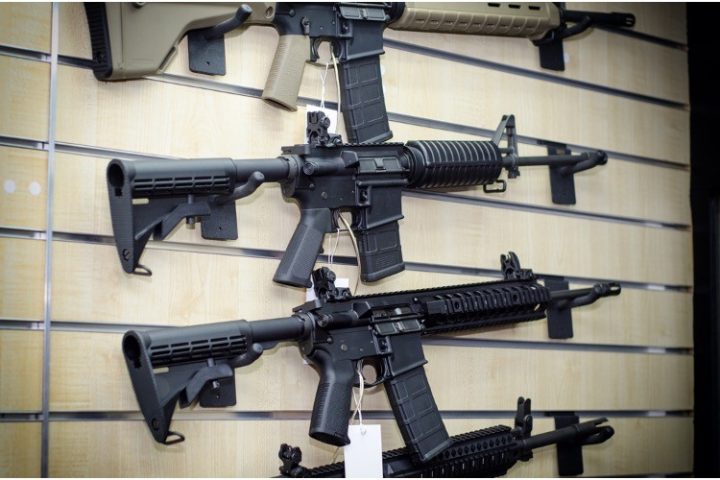
On Tuesday, CNN published a video segment titled “Why gun owners say they love AR-15 style rifles.” Some may wonder, “How could you love such a thing?!” Perhaps to the surprise of many, CNN did provide a glimpse into the answer. But the outlet also interviewed one of its military analysts, a retired Army officer, who appeared a voice of reason but whose statements were without reason.
The segment opened with CNN reporter Randi Kaye visiting Eagle Gun Range in Farmers Branch, Texas, where she introduced us to AR-15 aficionado Anna Thomasson. Thomasson wasn’t taught to shoot as a girl, but adopted the hobby in 2015 after a bout with breast cancer sidelined her marathon-running endeavors. She so fell in love with the activity that she, along with her husband, became AR-15 instructors.
Expressing her affinity for the weapon, the petite Thomasson explained that the AR is an extremely light rifle; hers is less than five pounds. This, along with it having virtually no recoil (kick), makes it very easy for a woman or any low-strength person to handle. The video below, of a seven-year-old girl firing an AR, attests to this. (In contrast, a handgun’s kick can be extreme.) Thomasson mentioned that she would not be able to effectively wield a 20-pound firearm.
Thomasson also explained that she wanted an AR for self-defense. Pointing out that her fists alone would be insufficient to fend off a male assailant, she expressed what was summed up in the famous saying, “God made man and woman; Sam Colt made them equal.”
After a couple of other gun-range interviews, CNN presented to the audience military analyst Lieutenant General Mark Hertling (Ret.). Yet while Hertling touted his experience “qualifying” on the military version of the AR-15, the M-16, the general was generally deceptive in his pronouncements.
Hertling first stated that the AR-15 was “designed as a weapon of war.” This is true.
So was the flintlock colonial Americans used in 1776.
For that matter, can you think of any type of firearm (bolt action, lever action, etc.) that was not designed as a “weapon of war”? The “weapon of war” line is an irrelevant observation, not an argument.
As for currency, no military I know of presently uses the AR-15 any more than it does a flintlock; in fact, even the M-16 and its variants are apparently being phased out by the U.S. Army.
Hertling then said that the AR-15 is “designed for catastrophic killing; it’s designed to damage tissue and cause organ dysfunction.” This is true, too. It’s also another irrelevant observation because, again, all firearms are thus designed. If they didn’t “damage tissue and cause organ dysfunction,” they couldn’t bring down an animal or neutralize a human threat.
In fact, far from devastating, the AR-15’s standard round is small caliber (similar to a .22’s diameter) and has the second least stopping power of the 58 cartridges found on this Rifle Cartridge Killing Power List page.
In fairness, the AR’s stopping power is somewhat greater when loaded with the 5.56 mm NATO round; moreover, it must be considered that military-grade ammo is designed to tumble and fragment upon hitting a target, which increases tissue damage. Nonetheless, the point is that you can acquire any number of hunting rifles more effective shot-per-shot than a standard-round AR. And a 12-gauge shotgun loaded with magnum buckshot is far more devastating against soft targets at close range than any rifle.
As for missing one’s target, Hertling hurtled completely off the range with his next claim. To wit: “We have seen the AR-15 used in almost 90 percent of the mass killings … in the United States,” he asserted.
Someone ought to ask for his data. While statistics can vary depending on how a given source defines “mass killings,” Statista informs that handguns were used in 76 percent of all mass-shooting incidents between 1982 and June 2022. (This includes incidents involving both handguns and rifles.) Rifles of any type were employed in a minority of these events.
This reflects a wider pattern, too, do note. As ABC reported last year, handguns are used in 62 percent of our country’s gun murders; in contrast, the FBI tells us that personal weapons (i.e., hands, fists, and feet) are used to kill more people yearly than rifles of any type.
Toward the end of his interview (below), Hertling also scoffed at the idea that people would used an AR for “varmint killing.” Well, a story: Approximately three decades ago, in a fine gun shop in upstate New York, I ran into a Vietnam veteran marksman who made money from the state by shooting coyotes. His weapon of choice? An AR-15.
Given the above, why are people so afraid of the AR? Because it’s black? (Hey, we can all play the race card!) Actually, propaganda is the answer — it’s often purposely spread, too. Just consider what anti-gun activist Josh Sugarmann admitted in 1989 about AR-15-style rifles.
“The weapons’ menacing looks,” he said, “coupled with the public’s confusion over fully-automatic machine guns versus semi-automatic assault weapons — anything that looks like a machine gun is assumed to be a machine gun — can only increase the chance of public support for restrictions on these weapons.”
Playing upon such ignorance is dishonest, but also effective. Yet most Americans would agree that we must be armed — with the truth. For whatever we decide on gun policy, it should be based on facts, not fiction-based fears.



